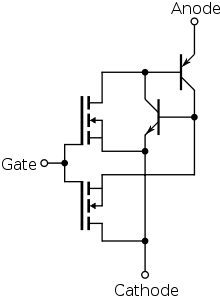MOS-controlled thyristor
An MOS-controlled thyristor (MCT) is a voltage-controlled fully controllable thyristor, controlled by MOSFETs (metal-oxide-semiconductor field-effect transistors). It was invented by V.A.K. Temple in 1984, and was principally similar to the earlier insulated-gate bipolar transistor (IGBT).[1] MCTs are similar in operation to GTO thyristors, but have voltage controlled insulated gates. They have two MOSFETs of opposite conductivity types in their equivalent circuits. One is responsible for turn-on and the other for turn-off. A thyristor with only one MOSFET in its equivalent circuit, which can only be turned on (like normal SCRs), is called an MOS-gated thyristor.

Positive voltage on the gate terminal with respect to the cathode turns the thyristor to the on state.
Negative voltage on the gate terminal with respect to the anode, which is close to cathode voltage during the on state, turns the thyristor to the off state.
These devices proved unwanted current crowding when fabricated, consequently small SOA (safe operating area),[2] so Fairchild withdrew them after brief commercialization.
External links
- Field-effect-controlled thyristor
- "MOS GTO—A Turn Off Thyristor with MOS-Controlled Emitter Shorts," IEDM 85, M. Stoisiek and H. Strack, Siemens AG, Munich FRG pp. 158–161.
- "MOS-Controlled Thyristors—A New Class of Power Devices", IEEE Transactions on Electron Devices, Vol. ED-33, No. 10, Oct. 1986, Victor A. K. Temple, pp. 1609 through 1618.
References
- V.A.K. Temple, "MOS-Controlled Thyristors, IEEE Electron Devices Meeting, Abstract 10.7, pp.282-285, 1984.
- B. Jayant Baliga, Advanced High Voltage Power Device Concepts, Springer Science & Business Media, Sep 21, 2011.